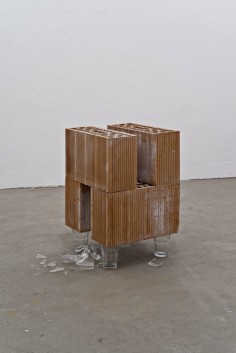ANDRÉ KOMATSU
source: sp-arte
André Komatsu (1978), é formado em Artes Plásticas pela Fundação Armando Álvares Penteado (FAAP), em São Paulo, cidade onde vive e trabalha.
Dentre as exposições individuais estão: Concreto/Periodico – Natalie Seroussi – Paris – França, 2010; Soma Neutra – Galeria Vermelho – São Paulo – Brasil, 2009; Projeto Bolsa Pampulha – Museu de Arte da Pampulha – Belo Horizonte – Brasil, 2006
Temporada de Projetos 2006 – Paço das Artes– São Paulo – Brasil, 2006. Programa de Exposições 2005-2006 – CCSP – Centro Cultural São Paulo – São Paulo – Brasil, 2006.
E dentre as exposições coletivas: Pra Começo de Século – Centro Dragão do Mar de Arte Contemporânea – Fortaleza – Brasil, 2010; Para ser Construídos – MUSAC- Castilla y Léon- Espanha, 2010; Obsession – Contemporary Art from the Lodeveans Collection – University of Leeds – Leeds – England, 2009; AFTER UTOPIA Museo Centro Pecci – Prato – Itália, 2009; When Lives Become Form: Creative Power from Brazil – Yerba Buena Center for the Arts – San Francisco – EUA, 2009.
When Lives Become Form: Creative Power from Brazil – Brazilian Embassy in Tokyo – MOT – Museum of Contemporary Art – Tóquio – Japão, 2008. Seja marginal, seja herói – Galerie GP & N Vallois & Galerie Natalie Seroussi – Paris – França, 2008.
.
.
.
.
.
.
.
source: sp-arte
The Brasilian André Komatsu was born in 1978 in Sao Paulo, where he still lives and works today. He studied fine arts at the Fundação Armando Álvares Penteado. In 2005 he won the Bolsa Pampulha Award and four years later Komatsu participated in a resident program at the Bronx Museum in New York.
Only in recent years, after being abundantly shown in his own country, the work of André Komatsu started to go beyond his borders. The artist describes his work as a reflection of a series of perceptions that are born by the meeting of streets, urban spaces, of which he observes the logic of construction and evolution. Starting from demolitions, abandoned objects, destroyed walls, Komatsu acts on a reconstruction, searching for new models of existence and coexistence. His instruments for communicating a political view from the bottom, made of tension and resistance, are drawing, sculpture, installation. Among the materials that he uses with more frequency are fragile crystal glasses and building components — often they must support the other, with the risk of breaking into a thousand pieces. Komatsu’s thought, in fact, lingers on the relationship itself between the parts of a sculpture, of artistic nature, but social before that, on its possibilities for survival and on its inevitable transformation in time.
Among Komatsu’s more important collective shows are Ponto de equilibrio (Insituto Tomie Ohtake, Sao Paulo, 2010) and The Peripatetic School (Drawing Room, Londra, 2011). In 2011 the artist received the Premio Illy for Sustain Art, assigned by ARCO Madrid, with the work Concreto Periodico, and had the opportunity to present a project for artist’s coffee cups.
In Sao Paulo André Komatsu has shown his work mainly at Galeria Vermelho.


